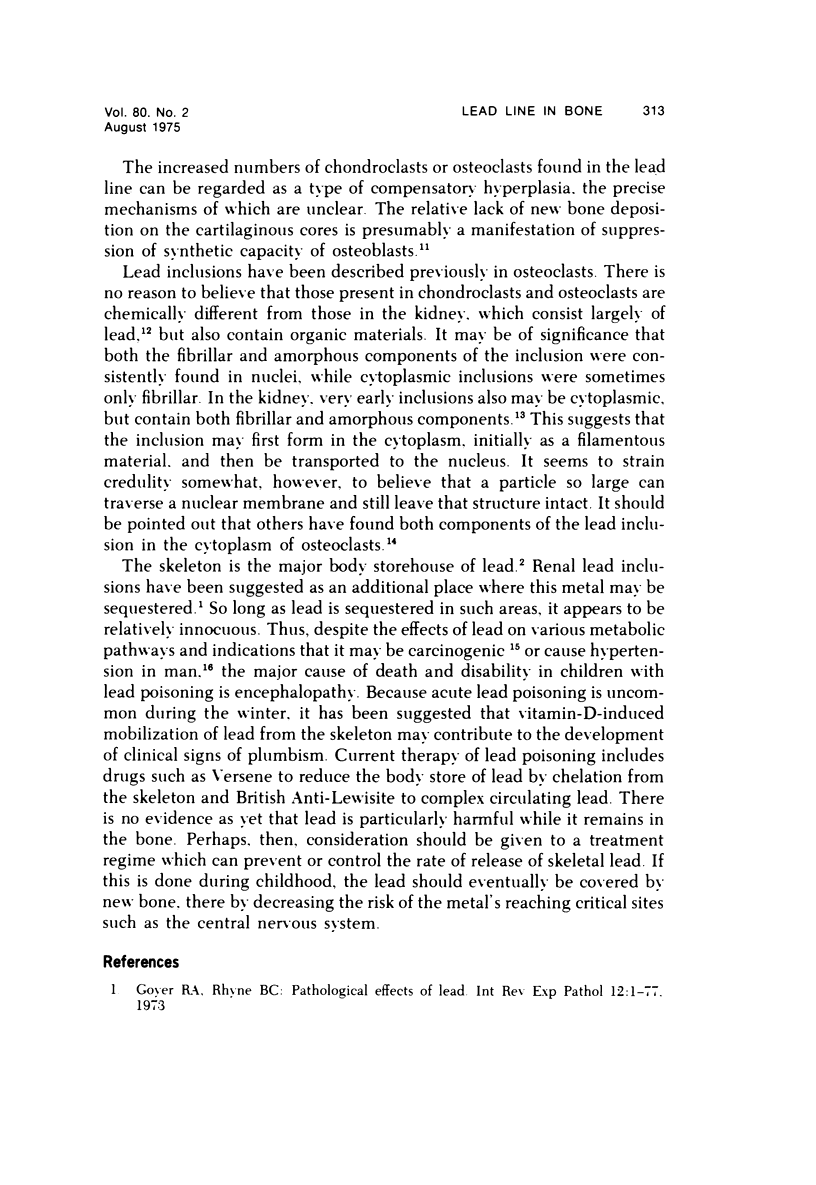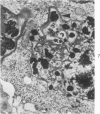Abstract
The metaphyseal line of increased radiodensity which occurs in lead poisoning was studied in children and young monkeys with lead encephalopathy and in guinea pigs. The histologic lesion consists of impaired resorption of calcified metaphyseal cartilage, depressed bone deposition on cartilaginous surfaces, and the accumulation of numerous multinucleate giant cells, some containing lead inclusions. By electron microscopy, the giant cells appear to be osteoclasts and chondroclasts containing large amounts of mineralized cartilage matrix. We interpret the lead line to be the result of a lead-induced inability of cartilage-resorbing cells to degrade mineralized matrix, with a resultant impairment of metaphyseal cartilage resorption. The radiodensity of the lead line would thus be due to persistent mineralized metaphyseal cartilage and not to a primary osseous change. Some observations on lead inclusions in these cells suggest that the fibrillar component forms before the amorphous part.
Full text
PDF







Images in this article
Selected References
These references are in PubMed. This may not be the complete list of references from this article.
- BOYLAND E., DUKES C. E., GROVER P. L., MITCHLEY B. C. The induction of renal tumors by feeding lead acetate to rats. Br J Cancer. 1962 Jun;16:283–288. doi: 10.1038/bjc.1962.33. [DOI] [PMC free article] [PubMed] [Google Scholar]
- BRIEGER H., RIEDERS F. Chronic lead and mercury poisoning: contemporary views on ancient occupational diseases. J Chronic Dis. 1959 Feb;9(2):177–184. doi: 10.1016/0021-9681(59)90157-2. [DOI] [PubMed] [Google Scholar]
- Battifora H., Eisenstein R., Laing G. H., McCreary P. The kidney in experimental magnesium deprivation. a morphologic and biochemical study. Am J Pathol. 1966 Mar;48(3):421–437. [PMC free article] [PubMed] [Google Scholar]
- Choie D. D., Richter G. W. Lead poisoning: rapid formation of intranuclear inclusions. Science. 1972 Sep 29;177(4055):1194–1195. doi: 10.1126/science.177.4055.1194. [DOI] [PubMed] [Google Scholar]
- Clasen R. A., Hartmann J. F., Coogan P. S., Pandolfi S., Laing I., Becker R. A. Experimental acute lead encephalopathy in the juvenile rhesus monkey. Environ Health Perspect. 1974 May;7:175–185. doi: 10.1289/ehp.747175. [DOI] [PMC free article] [PubMed] [Google Scholar]
- Goyer R. A., May P., Cates M. M., Krigman M. R. Lead and protein content of isolated intranuclear inclusion bodies from kidneys of lead-poisoned rats. Lab Invest. 1970 Mar;22(3):245–251. [PubMed] [Google Scholar]
- HASS G. M., BROWN D. V., EISENSTEIN R., HEMMENS A. RELATIONS BETWEEN LEAD POISONING IN RABBIT AND MAN. Am J Pathol. 1964 Nov;45:691–727. [PMC free article] [PubMed] [Google Scholar]
- Hsu F. S., Krook L., Shively J. N., Duncan J. R., Pond W. G. Lead inclusion bodies in osteoclasts. Science. 1973 Aug 3;181(4098):447–448. doi: 10.1126/science.181.4098.447. [DOI] [PubMed] [Google Scholar]
- Schenk R. K., Spiro D., Wiener J. Cartilage resorption in the tibial epiphyseal plate of growing rats. J Cell Biol. 1967 Jul;34(1):275–291. doi: 10.1083/jcb.34.1.275. [DOI] [PMC free article] [PubMed] [Google Scholar]
- Whalen J. P., Winchester P., Krook L., Dische R., Nunez E. Mechanisms of bone resorption in human metaphyseal remodeling. A roentgenographic and histologic study. Am J Roentgenol Radium Ther Nucl Med. 1971 Jul;112(3):526–531. doi: 10.2214/ajr.112.3.526. [DOI] [PubMed] [Google Scholar]








